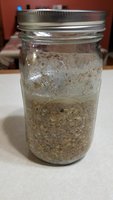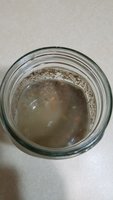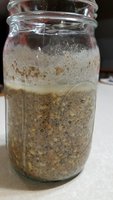I just started fermenting feed a couple weeks ago. I do have some question on fermenting. I am using Scratch and Pecks Naturally Free Organic Layers. I am including some pictures below. I have been fermenting for 3 days and stirring daily. So here are my quesitons



- Mine turns out very soupy. Do you drain off all the liquid and just feed the grain? Or dump the entire thing into the feed bowl?
- The first couple times I set it out they finished most all of it. For the past couple days they have eaten maybe half or less. (I am only fermenting a cup at a time). Is it safe to keep the uneaten out till it is gone or should I pull it. For safety and not knowing I have been pulling it out and dumping it then giving fresh the next day. Unfortunately this is creating allot of waste.








 It may very how much of each will give you the right consistency depending on which feed you use. So just experiment with ratios and you'll get it down pretty quickly.
It may very how much of each will give you the right consistency depending on which feed you use. So just experiment with ratios and you'll get it down pretty quickly. 




